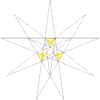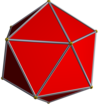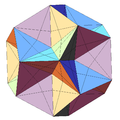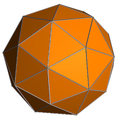Excavated dodecahedron
| Excavated dodecahedron | |||||||
|---|---|---|---|---|---|---|---|
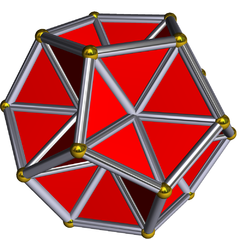
| |||||||
| Type | Stellation | ||||||
| Index | W28, 26/59 | ||||||
| Elements (As a star polyhedron) |
F = 20, E = 60 V = 20 (χ = −10) | ||||||
| Symmetry group | icosahedral (Ih) | ||||||
| Dual polyhedron | self | ||||||
| |||||||
In geometry, the excavated dodecahedron is a star polyhedron. Its exterior surface represents the Ef1g1 stellation of the icosahedron. It is also a facetting of the dodecahedron. When treated as a self-intersecting polyhedron, it is a noble polyhedron, having 20 star hexagons as faces. Although it is named the excavated dodecahedron, this is not strictly correct: a true excavated dodecahedron would have only the visible triangular faces instead of hexagonal ones.
The 20 vertices of the convex hull match the vertex arrangement of the dodecahedron.
Related polyhedra
-
The excavated dodecahedron as the third stellation of icosahedron.
-
One of the star hexagon faces highlighted.
-
It is related to the pentakis dodecahedron, but has inverted pyramids.
The star hexagon face can be broken up into four equilateral triangles, three of which are the same size. A truly excavated dodecahedron would have the three congruent equilateral triangles as true faces of the polyhedron, while the interior equilateral triangle would be fully inside the polyhedron and would thus not be counted.
It is topologically equivalent to the {6, 6} hyperbolic tiling, by making the hexagons regular. As such, it is a regular polyhedron of index two:[1]
References
- ^ The Regular Polyhedra (of index two), David A. Richter
| Notable stellations of the icosahedron | |||||||||
| Regular | Uniform duals | Regular compounds | Regular star | Others | |||||
| (Convex) icosahedron | Small triambic icosahedron | Medial triambic icosahedron | Great triambic icosahedron | Compound of five octahedra | Compound of five tetrahedra | Compound of ten tetrahedra | Great icosahedron | Excavated dodecahedron | Final stellation |
|---|---|---|---|---|---|---|---|---|---|

|

|

|
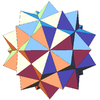
|
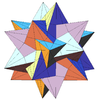
|

|

|
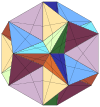
|

| |
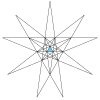
|

|

|

|

|

|

|

|

| |
| The stellation process on the icosahedron creates a number of related polyhedra and compounds with icosahedral symmetry. | |||||||||

